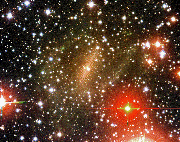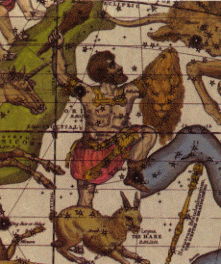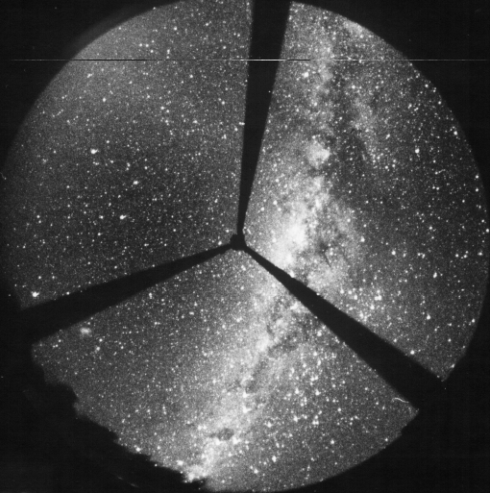
|| Home || Solar System || Quiz || Glossary || Aliens || UFOs || Space Craft || Satellites ||
|| Origin Of Universe || Comets || Constellation || Galaxy || Stars || Asteroids || Meteors & Meteorites ||

Before the universe as we now know it existed, there was no space or time. The Big Bang and its associated theories try to explain or describe the moment of change from nothingness and no time to the existence of the universe filled with space and marked by time. Many physicists describe this event as an explosion, or flash, hence the name Big Bang. The big bang is a process of expansion in our universe that is still active today.
The universe flashed into existence (according to the Big Bang theory) from a very small agglomeration of matter of extremely high density and temperatures. As a dense, hot globule of gas, containing nothing but hydrogen and a small amount of helium, it began expanding rapidly outward. There were no stars or planets. The first stars probably began to condense out of the primordial hydrogen when the universe was about 100 million years old and continued to form as the universe aged. The Sun was formed in this way 4.6 billion years ago. Many stars came into being before the Sun was formed; many others formed after the Sun appeared. This process continues, and through telescopes we can now see stars forming out of compressed pockets of hydrogen in outer space.
In 1992 instruments aboard the Cosmic Background Explorer (COBE) satellite, launched in 1989, showed that 99.97% of the radiant energy of the universe was released within the first year of the Big Bang event. This evidence seems to confirm the Big Bang theory. In March 1995 astronomers found more supporting evidence for the big bang when they concluded that data obtained from the space shuttle's Astro 2 observatory showed that helium was widespread in the early universe. The Big Bang theory holds that hydrogen and helium were the first elements created when the universe was formed. Astronomers also theorize that 99% of the matter in the universe is invisible, or dark matter, composed of some kind of matter that they cannot yet detect.
In 1999 the age of the cosmos was determined by NASA's Hubble Space Telescope Key Project Team to be about 12 billion years old (plus or minus 10%), with a maximum age of 18 billion years, depending on a number of variables.

For several billion years, comets probably struck Earth and caused major changes to Earth's early atmosphere and climate. Their impacts with Earth may have delivered the first carbon-based molecules to our planet. As some of the least changed objects in our solar system for billions of years, they may yield important clues about the formation of our solar system. A Deep Space 1 spacecraft took the highest-resolution pictures ever of a comet's nucleus, adding volumes of information to comet science in just one day.

The constellations are totally imaginary things that poets,
farmers and astronomers have made up over the past 6,000 years (and probably
even more!). The real purpose for the constellations is to help us tell which
stars are which, nothing more. On a really dark night, you can see about 1000 to
1500 stars. Trying to tell which is which is hard. The constellations help by
breaking up the sky into more manageable bits. They are used as mnemonics,
or memory aids. For example, if you spot three bright stars in a row in the
winter evening, you might realize, "Oh! That's part of Orion!"
Suddenly, the rest of the constellation falls into place and you can declare:
"There's Betelgeuse in Orion's left shoulder and Rigel is his foot."
And once you recognize Orion, you can remember that Orion's Hunting Dogs are
always nearby. Then you might recognize the two bright stars in the upper and
lower left of the photograph as Procyon in Canis Minor and Sirius in Canis
Major, respectively.
When you look in a sky atlas, you might see diagrams like this:

This type of schematic draws the stars as different sizes to represent different
brightnesses.In addition, there is a standard way to connect the stars that
allow astronomers and others who use charts like this to quickly tell what they
are looking at.You might also notice that every star on the chart is labeled.This
chart is useful because it accurately shows the relative positions of the stars
in this small region of the sky.
Around the world, farmers know that for most crops, you plant in the spring and harvest in the fall. But in some regions, there is not much differentiation between the seasons. Some historians suspect that many of the myths associated with the constellations were invented to help the farmers remember them. When they saw certain constellations, they would know it was time to begin the planting or the reaping.
This dependence on the sky became a strong part of many cultures. Perhaps there is something about the mystery of the night sky that makes people want to tell stories about the constellations.
The constellations have changed over time. In our modern world, many of the constellations have been redefined so now every star in the sky is in exactly one constellation. In 1929, the International Astronomical Union (IAU) adopted official constellation boundaries that defined the 88 official constellations that exist today.
A galaxy, large aggregation of stars, gas, and dust, typically containing billions of stars.
It isa large system of stars held together by mutual gravitation and isolated from similar systems by vast regions of space.
Recognition that galaxies are independent star systems outside the Milky Way came from a study of the
Andromeda Galaxy (1926–29) by Edwin P. Hubble that indicated the great distances at which this and other galaxies are located. Previously, the galaxies had been classified with the luminous gas clouds, or bright nebulae, within the Milky Way. The sun and its solar system, as well as the visible stars, are all in the Milky Way galaxy. Harlow Shapley encouraged the exclusive use of the term “galaxies.” Billions of galaxies are within the optical range of the largest telescopes; in 1996 analysis of photographs taken from the Hubble Space Telescope increased the estimated number of galaxies from 10 billion to 50 billion. A galaxy is held together by the gravitational attraction between its constituent parts (see gravitation), while its rotational motion prevents it from collapsing on itself. Just as gravitation binds individual stars into galaxies, it also acts to hold clusters of galaxies together. Many large galaxies have smaller galaxies, called satellite galaxies, in close proximity. The galaxies nearest the Milky Way form a cluster called the local group. The local group includes the Andromeda Galaxy, which is similar to the Milky Way, and the Magellanic Clouds, which are satellite galaxies of the Milky Way. The vast majority of observed galaxies are classified as either spiral or elliptical (football-shaped), with a small minority, e.g., the Magellanic Clouds, classified as irregular according to a scheme originated by Hubble. Although estimates of the age of the universe are controversial (see Hubble's law), if it is taken as 15 billion years, then it is estimated that the first galaxies were formed 12.8–13.5 billion years ago.
A typical spiral galaxy is shaped like a flat disk, about 100,000 light-years in diameter, with a central bulge, or nucleus, containing old stars; winding through the disk are the characteristic spiral arms of dust, gas, and young stars (see stellar populations). This type of galaxy is further classified as being either a normal or a barred spiral. In the normal spiral, the arms, at least two in number, join smoothly with the nucleus; in the barred spiral, the arms project from a bank of stars that runs through the nucleus. The elliptical galaxies, lacking spiral arms entirely and containing little or no gas and dust, resemble the nuclei of spiral galaxies. Their shapes vary from nearly spherical to highly flattened ellipsoids. Elliptical galaxies have a much greater variation in size, mass, and luminosity than do spiral galaxies; their sizes range from the largest known galaxies of all, with luminosities about 10 times that of the Andromeda Galaxy, to the small dwarf ellipticals, which can contain as few as a million stars. Irregular galaxies appear structureless and without any nucleus or rotational symmetry; their light comes mostly from young stars.
Spiral galaxies contain a larger number of bluer, younger stars, while elliptical galaxies contain a larger number of redder, older stars. This has led astronomers to believe that stars initially cluster into into spiral galaxies and that over time structural changes transform them into elliptical galaxies. Some researchers speculate that this is caused by collisions of galaxies as they travel through space, while others hypothesize that the transformation occurs because of gravitational forces exerted by galaxies as they slowly pass each other. Computer simulations suggest a third alternative, called “galactic harassment,” in which galaxies interact although they remain far apart and pass each other at high speeds.
Many galaxies radiate a large fraction of their energy in forms other than visible light. With the development of radio astronomy, many radio galaxies were discovered. Other galaxies radiate strongly in the infrared, ultraviolet, or X-ray parts of the spectrum.
Andromeda Galaxy
 |
Andromeda Galaxy, cataloged as M31 and NGC 224, the closest large galaxy to the Milky Way and the only one visible to the naked eye in the Northern Hemisphere. It is also known as the Great Nebula in Andromeda. It is 2.2 million light-years away and is part of the local group of several galaxies that includes the Milky Way, which it resembles in shape and composition. It has a diameter of about 165,000 light-years and contains at least 200 billion stars. Its two brightest companion galaxies are M32 and M110. The light arriving at earth from the Andromeda Galaxy is shifted toward the blue end of the spectrum, whereas the light from all other cosmic sources exhibits red shift. |
 |
Milky Way, the galaxy of which the sun and solar system are a part, seen as a broad band of light arching across the night sky from horizon to horizon; if not blocked by the horizon, it would be seen as a circle around the entire sky. Although its motion is not readily apparent, the entire galaxy is rotating about the Milky Way's center. Relative to the universe, the galaxy is moving at a speed of c.370 mi per sec (c.590 km per sec) in the same direction that the constellation Leo lies relative to the earth; it is also moving at c.60 mi per sec (c.100 km per sec) relative to the center of mass of the local group of galaxies. The sun, traveling at a speed of c.150 mi per sec (c.240 km per sec) in a nearly circular orbit, takes 200–230 million years to complete one revolution. |
 |
 |
 |
![]()
A star such as our own Sun was born when enormous clouds of dust and gas, stretching over 2 light years, collapsed under the force of gravity. As this material was compressed it gradually warmed up to temperatures of 15 million degrees. At this point nuclear fusion began in its core and energy in the form of heat and light traveled out from the center. As long as there is still material within the star the nuclear fusion process can continue with hydrogen being fused to form helium.
When, however, it has used up its core hydrogen fuel, the star starts to fuse helium and eventually other elements. During this time the star will expand into a red giant or super-giant, becoming tens or even hundreds of times larger. Eventually, no more fuel will be available and the star will collapse under gravity to form a white dwarf star only a few thousand kilometers in diameter.
Birth and Death of a Star
Astronomers think that a star begins to form as a dense cloud of gas in the arms of spiral galaxies. Individual hydrogen atoms fall with increasing speed and energy toward the center of the cloud under the force of the star's gravity. The increase in energy heats the gas. When this process has continued for some millions of years, the temperature reaches about 20 million degrees Fahrenheit. At this temperature, the hydrogen within the star ignites and burns in a continuing series of nuclear reactions. The onset of these reactions marks the birth of a star. When a star begins to exhaust its hydrogen supply, its life nears an end. The first sign of a star's old age is a swelling and reddening of its outer regions. Such an aging, swollen star is called a red giant. The Sun, a middle-aged star, will probably swell to a red giant in 5 billion years, vaporizing Earth and any creatures that may be on its surface. When all its fuel has been exhausted, a star cannot generate sufficient pressure at its center to balance the crushing force of gravity. The star collapses under the force of its own weight; if it is a small star, it collapses gently and remains collapsed. Such a collapsed star, at its life's end, is called a white dwarf. The Sun will probably end its life in this way. A different fate awaits a large star. Its final collapse generates a violent explosion, blowing the innards of the star out into space. There, the materials of the exploded star mix with the primeval hydrogen of the universe. Later in the history of the galaxy, other stars are formed out of this mixture. The Sun is one of these stars. It contains the debris of countless other stars that exploded before the Sun was born.
Between the orbits of Mars and Jupiter are an estimated 30,000 pieces of rocky debris, known collectively as the asteroids, or planetoids. The first and, incidentally, the largest (Ceres), was discovered during the New Year's night of 1801 by the Italian astronomer Father Piazzi (1746–1826), and its orbit was calculated by the German mathematician Karl Friedrich Gauss (1777–1855). Gauss invented a new method of calculating orbits on that occasion. A few asteroids do not move in orbits beyond the orbit of Mars, but in orbits that cross the orbit of Mars. The first of them was named Eros because of this peculiar orbit. It had become the rule to bestow female names on the asteroids, but when it was found that Eros crossed the orbit of a major planet, it received a male name. These orbit-crossing asteroids are often referred to as the “male asteroids.” A few of them—Albert, Adonis, Apollo, Amor, and Icarus—cross the orbit of Earth, and two of them may come closer than our Moon; but the crossing is like a bridge crossing a highway, not like two highways intersecting. Hence there is very little danger of collision from these bodies. They are all small, 3 to 5 mi (4.8 to 8.0 km) in diameter, and therefore very difficult objects to identify, even when quite close. Some scientists believe the asteroids represent the remains of an exploded planet.
On Oct. 29, 1991, the Galileo spacecraft took a historic photograph of asteroid 951 Gaspra from a distance of 10,000 mi (16,000 km) away. It was the first close-up photo ever taken of an asteroid in space.
Gaspra is an irregular, potato-shaped object about 12.5 mi (20 km) by 7.5 mi (12 km) by 7 mi (11.2 km) in size. Its surface is covered with a layer of loose rubble and its terrain is covered with several dozen small craters.
Close-up photos of asteroid 243 Ida taken by the Galileo spacecraft on Aug. 28, 1993, revealed that Ida had a tiny egg-shaped moon measuring 0.9 by 0.7 mi (1.44 by 1.12 km). The moon has been named Dactyl.
NASA's Near-Earth Asteroid Rendezvous spacecraft was launched on Feb. 17, 1996. (Near-Earth asteroids come within 121 million miles [195 million kilometers] of the Sun. Their orbits come close enough that one could eventually hit Earth.) It flew within 750 mi (1,200 km) of minor planet 253 Mathilde on June 27, 1997, and took spectacular images of the dark, crater-battered world. The asteroid's mean diameter was found to be 33 mi (52.8 km). The NEAR spacecraft discovered that the carbon-rich Mathilde is one of the darkest objects in the solar system, only reflecting about 3% of the Sun's light, making it twice as dark as a chunk of charcoal. The asteroid is almost completely cratered, and at least five of its craters just on the lighted side are larger than 12 mi (19.2 km).
The spacecraft reached asteroid 433 Eros in Dec. 1998, but because of engine problems its original mission to enter into the asteroid's orbit was aborted, and NEAR flew past Eros instead. However, the spacecraft was reset, and on Feb. 14, 2000, NEAR successfully entered into orbit around Eros. NEAR remained in orbit for one year, taking photographs of the asteroid and gathering information about its composition, structure, size, and shape. The spacecraft landed safely on the surface of Eros in a controlled crash on Feb. 12, 2001. Against tremendous odds, it continued to relay information for another two weeks before being shut down.
NEAR measured Eros to be 21 mi (33.6 km) long by 8 mi (12.8 km) wide and 8 mi (12.8 km) deep. It rotates once every 5.27 hours and has no visible moons. NEAR data also showed that the asteroid's ancient surface is covered with craters, ridges, boulders, and other complex features.
NEAR was the first spacecraft to orbit an asteroid and the first craft to operate on solar power so far from the Sun. NEAR gathered about 160,000 images of Eros, about 10 times more than was planned. The spacecraft was renamed NEAR-Shoemaker in honor of geologist Dr. Eugene M. Shoemaker (1928–1997), who researched the influence of asteroids and comets in shaping planets

The term meteor for what is usually called a shooting star bears an unfortunate resemblance to the term meteorology, the science of weather and weather forecasting. This resemblance is due to an ancient misunderstanding that wrongly considered meteors an atmospheric phenomenon. Actually, the streak of light in the sky that scientists call a meteor is essentially an astronomical phenomenon: the entry of a small piece of cosmic matter into our atmosphere.
The distinction between meteors and fireballs (formerly also called bolides) is merely one of convenience; a fireball is an unusually bright meteor. Incidentally, it also means that a fireball is larger than a faint meteor.
Bodies that enter our atmosphere become visible when they are about 60 mi above the ground. The fact that they grow hot enough to emit light is not due to the “friction” of the atmosphere, as one often reads. The phenomenon responsible for the heating is one of compression. Unconfined air cannot move faster than the speed of sound. Since the entering meteorite moves with 30 to 60 times the speed of sound, the air simply cannot get out of the way. Therefore, it is compressed like the air in the cylinder of a diesel engine and is heated by compression. This heat—or part of it—is transferred to the moving body. The details of this process are now fairly well understood as a result of reentry tests with ballistic-missile nose cones.
The average weight of a body producing a faint shooting star is only a small fraction of an ounce. Even a bright fireball may not weigh more than 2 or 3 lb. Naturally, the smaller bodies are worn to dust by the passage through the atmosphere; only rather large ones reach the ground. Those that are found are called meteorites. (The meteor, to repeat, is the term for the light streak in the sky.) About 1,000 meteorites fall to Earth each year.
The largest meteorite known is still embedded in the ground near Grootfontein in southwest Africa and is estimated to weigh 70 tons. The second-largest known is the 34-ton Anighito (on exhibit in the Hayden Planetarium, New York), which was found by Admiral Peary in 1892 at Cape York in Greenland. The largest meteorite found in the United States is the Willamette meteorite (found in Oregon, weight ca. 15 tons), but large portions of this meteorite weathered away before it was found. Its weight as it struck the ground may have been 20 tons.
All these are iron meteorites (an iron meteorite normally contains about 7% nickel), which form one class of meteorites. The other class consists of the stony meteorites, and between them there are the so-called stony irons. Tektites consist of silica-rich glass similar to our volcanic glass obsidian, and because of the similarity, there is doubt in a number of cases whether the glass is of terrestrial or of extraterrestrial origin.
Though no meteorite larger than the Grootfontein is actually known, we do know that Earth has, on occasion, been struck by much larger bodies. Evidence for such hits are the meteorite craters, of which an especially good example is located near the Cañon Diablo in Arizona. Another meteor crater in the United States is a rather old crater near Odessa, Tex. A large number of others are known, especially in eastern Canada; and for many “probables,” meteoric origin has now been proved.
The 13th known lunar meteorite was found in Dec. 1993 by a team from the Antarctic Search for Meteorites project. It is approximately 2 in. long and weighs 0.75 oz.
Some scientists theorize that the mass extermination of dinosaurs from the face of Earth 65 million years ago was due to a large meteor that struck our planet at that time.
Meteor showers are caused by multitudes of very small bodies traveling in swarms. Earth travels in its orbit through these swarms like a car driving through falling snow. The point from which the meteors seem to emanate is called the radiant and is named for the constellation in that area. The Perseid meteor shower in August is the most spectacular of the year, boasting, at peak, roughly 60 meteors per hour under good atmospheric conditions. The presence of a bright moon diminishes the number of visible meteors.
| Home || Solar System || Quiz || Glossary || Aliens || UFOs || Space Craft || Satellites ||